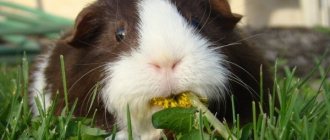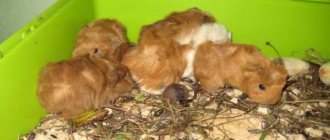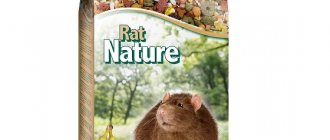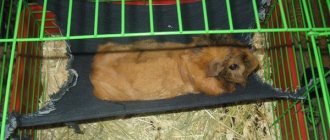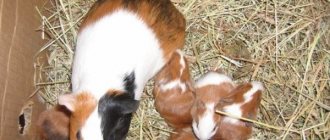!! Bedding for guinea pigs is not only a soft floor in the cage, but also a toilet and a place to play. The material used in the bedding must be soft to protect the animal’s paws from the appearance of calluses, and also have hygroscopic properties, that is, it can absorb moisture well.
It is worth remembering that a pig is a rodent that digs holes in the wild, so the litter filler should be loose. Improper selection of bedding and untimely replacement or cleaning can lead to various diseases: pododermatitis, urinary dermatitis, fungus, baldness, conjunctivitis, mechanical damage to bones, respiratory and digestive diseases, scabies, pediculosis, mites, alopecia, herpes, abscesses, cystitis, external otitis, keratitis.
Finding a material that would be universal and fit all of the above properties is almost impossible. Therefore, when creating bedding, at least two fillers are used, and sometimes even three. Fillers are arranged in layers, where the bottom layer is absorbent and the top layer is soft. The cage can also be divided into sections, which allows you to use different combinations of fillers for bedding.
Overview of different types of bedding: pine shavings
The material is well ventilated and absorbs moisture. One of the most readily available cage fillers and can be obtained from almost any carpenter. The shavings must be carefully sifted and large and sharp chips must be removed. Next, it is dried and ventilated to get rid of pine essential oils.
Pros: Low cost of the material, high hygroscopic properties, allows the pig to dig minks. Can serve as the only filler for bedding.
Cons: Risk of damage to the rodent's legs and eyes from knots.
Constantly cleaning the area around the cage, as the pig will scatter shavings while playing. To avoid such a situation, plexiglass is installed in the cage.
What kind of bedding to prepare for childbirth
To breed offspring, female pigs collect a nest. For this they will need pieces of paper and rags. Before giving birth, the pig is moved into a separate cage, which is thoroughly washed and disinfected beforehand.
There is no litter or bedding that is suitable for all guinea pigs. Each individual has its own preferences or requirements based on physical characteristics. Therefore, the type of filler is chosen individually for each pet, and at the same time, its reaction to the new gender is closely monitored.
Hay and straw
Hay and straw are used only in combination with other absorbent material that will absorb moisture, for example, shavings, sawdust, wood pellets. These fillers provide air access to the rodent’s belly: when the cage is poorly ventilated, the skin on the guinea pig’s belly “burns” and hair falls out due to excess moisture. Hay and straw can be bought at pet stores, but for those who want to save hay, you can make it yourself.
Hay for a pig is dried grass with stems of chamomile, dandelion, alfalfa; this composition will not only serve as bedding, but will also supplement the animal’s diet with all the necessary vitamins. It is best to make hay in the spring, when the mown grass is full of vitamins and minerals. You can dry hay on the balcony or in any other room where there is good ventilation. During drying, the hay should be turned over periodically to avoid diaper rash and damage to the material.
Pros: Hay absorbs odors perfectly, has a huge supply of vitamins and brings the pig as close as possible to the wild environment.
Cons: Hay and straw do not absorb moisture; they are used only in conjunction with absorbent filler. Straw does not absorb odors well and can injure the pig due to the sharp stems.
Tips for choosing the best litter for guinea pigs
IMPORTANT: When choosing bedding for guinea pigs, you should pay attention to the composition of the filler. If it contains harmful substances, it will negatively affect the health of the pet.
You can also ask friends and acquaintances who keep pigs at home about what kind of litter they use. Or the seller at the pet store will be able to suggest the characteristics of a particular product and will definitely select the appropriate option for your pet.
Sawdust
This filler has good absorbent characteristics. Designed for use as the bottom layer of bedding. Sawdust can be of different fractions. Small sawdust can cause problems in the respiratory system of a rodent, so you should buy a large fraction. It is quite easy to purchase sawdust - at any pet store or furniture shop. As in the case of shavings, sawdust also needs to be dried before use and sorted out, removing all sharp chips.
Pros: Low cost of material, absorbs moisture and odors well.
Cons: The fine fraction can cause respiratory tract disease and conjunctivitis.
Poor absorption of odors. Long-haired pigs will need to periodically clean their fur to remove sawdust. Constant cleaning of the area around the cage.
Food for thought: is it worth using?
Different owners are accustomed to different types of bedding, perhaps without particularly thinking about their advantages or disadvantages. Let's try to systematize the most frequently used ones.
Paper and others
This includes paper napkins, towels made of the same material, toilet paper and even newspaper. The option seems to be good and quite budget-friendly, but it is very impractical: such bedding is instantly saturated with urine and the corresponding smell. You can, of course, change them very often, but is it worth it?
In general, newspaper should be used only in emergency cases, when, say, the usual filler has run out. Then, having laid a thick layer of newspaper on the floor as an absorber, hay is placed on top.
Other “non grata” fillers include corn. In addition to the fact that it “can” become moldy, there have been cases when rodents had problems with their paws, or more precisely, with their soles.
Often pigs mistake it for food, and it swells in the stomach, which is harmful to the pet’s health.
Such bedding cannot be used on its own, and if it is used, then only as a bottom layer.
Hay/straw
These options as bedding are not the best solution. Rodents see them primarily as food. However, some experts believe that hay can be used in combination, for example, with a soft and highly absorbent cellulose filler.
This “combined” bedding is suitable for pigs with thick hair or for breeds with coarse and short hair.
But it is not recommended to use straw as bedding - it has quite a lot of “contraindications”:
- does not absorb moisture,
- is rotting
- has an unpleasant odor
- is dangerous - its hard stems can injure the pig, especially the eyes.
Only as a last resort can you lay straw on top of the shavings for a while.
Coniferous shavings
Pine shavings must be dried and ventilated, unless purchased already in such conditions. This will help get rid of essential oils that have a bad effect on the respiratory system of animals.
The disadvantage (not the most terrifying, it should be noted) is that during the pets playing and jumping in the cage, shavings and sawdust fly out of it, covering the floor around it.
Essential oils of cedar shavings are considered more aggressive. Despite the fact that they are capable of exterminating all kinds of insects, in addition to problems with the respiratory system of their favorite animals, they also create problems with the liver.
Since there is no urgent need to use this particular material for bedding, it is better to refrain from using it.
Wood granules, pellets
Wood pellets or pellets are sawdust pressed under high temperatures. Well suited not only as litter for kittens and rabbits, but also for guinea pigs. In bedding, pellets can be used as the only filler, in combination with other fillers - sawdust occupies the bottom layer, which should absorb all the moisture. Pellets are sold in almost every construction or gardening store. But if you want to be sure of the quality of the material, then it is better to purchase pellets in pet stores, where they are packaged into fractions. You should also pay attention to what the granules are made of; it should be cellulose or wood. Otherwise, low-quality pellets can cause problems in the pig’s digestive tract, because she will chew them.
Pros: Easy to use, absorbs moisture and odor, can be used as the only bedding filler.
Cons: Constant cleaning around the cage, cost of material.
Main tasks of litter
Guinea pig bedding performs several functions:
- Toilet.
- Place to play.
- To maintain the health of the genitourinary system.
The litter for the toilet should completely absorb the animal's excrement, urine and water. It's no secret that guinea pigs love to play and almost never sit in one place. Therefore, they are often buried in a filler that resembles soil or hay in consistency. In addition, these rodents are highly likely to develop diseases associated with the genitourinary system, the development of fungi and baldness.
IMPORTANT: A pet needs a correctly selected litter not only for convenience, but also to maintain health.
What types of bedding are there?
Napkins, paper towels
Napkins and paper towels can be used as a temporary moisture-absorbing filler for bedding, which is used only in combination with other material: shavings, hay, fleece and PVC mats. As for newspapers, their use is strictly prohibited, because printing ink is toxic to pigs due to its lead content.
Pros: Low price, hypoallergenic, accessible.
Cons: Gets wet quickly. Can only be used mixed with other fillers
Bed
Unlike bedding, a bed is not a mandatory attribute in a pet's cage, but a piglet will appreciate a cozy place to sleep. The bed should be spacious enough so that the animal can stretch out its legs if desired. Soft sides are also welcome; the animal can use them as a pillow.
At the pet store you can find beds of various sizes and colors. A comfortable mattress or bag can be easily made with your own hands: sewn or knitted. If the owner sewed the bed herself, taking into account all the features of the pet, then the likelihood that the animal will fall in love with the new sofa is higher.
PVC and fleece rugs
Rugs made of PVC and fleece are popular materials for bedding; they are used only in combination with other fillers that will absorb moisture: sawdust, shavings, pellets. These rugs have a colorful design, in the form of pictures on different topics. When choosing such a rug, you should pay attention to the fact that it must consist of 100% polyester. The surface of the mat should not contain long threads in which the pig could become entangled. You need to wash the rug without fabric softener, because it significantly impairs the water permeability of the material.
Pros: These rugs are warm, soft and aesthetically pleasing; they can be reused many times.
Cons: Small debris sticks to the material and is very difficult to clean off; washing is required.
There are many materials for filling bedding; every guinea pig owner will be able to choose a filler for the cage according to their wallet. But all types of bedding must be promptly replaced and the cage cleaned.
Advantages and disadvantages of existing fillers
The advantages of litter for guinea pigs are that they can get rid of unpleasant odors, excess moisture in the pet and protect it from the development of certain diseases.
The disadvantages include the fact that not all fillers do their job well. Although a guinea pig is not demanding in terms of care, its owner will have to change the litter almost every day. Of course, it all depends on what type of bedding you choose.
You should carefully study the composition of the litter before purchasing
Cleaning the cage
You need to clean your guinea pig's cage daily, following this procedure:
- The first step is to remove any remaining food and waste.
- Next, wipe the contaminated areas with wet paper towels.
- Change water and food. In this case, the bowls must be washed each time in hot, soapy water.
At least once a week, the cage should be thoroughly cleaned. During such cleaning, all bedding is removed from the cage, everything is washed in hot water. The cage is washed with mild detergents, wiped down and filled with bedding. The amount of litter directly depends on the size of the cage. As a rule, the bottom of the cage is filled several centimeters so that the pig can move around without hindrance.
ARTICLE 2: Himalayan guinea pig - Description and photo
Polyvinyl chloride or PVC mat
Many rodent owners have recognized the PVC mat as the best bedding. The rug can be purchased at any hardware store. It is soft for the animal's paws and easy to clean. Sawdust or wood pellets are usually placed under the mat. This solves the problem of excess moisture and unpleasant odor.
This type of bedding has only one drawback: curious animals can crawl under the rug and chew its edges. But this can be easily fixed; the mat must be firmly secured. Securing the bedding also helps keep the area around the cage clean.
To maintain cleanliness, the bedding should be wiped with a damp cloth and washed once a week in a washing machine at 30 degrees on the shortest cycle.
Common mistakes in training
Owners of guinea pigs should take into account that in most cases, toilet training these pets is much more difficult than instilling a similar skill in a kitten. Therefore, you need to be patient and try to avoid mistakes that complicate the process. There are several common violations:
- screaming, physical punishment;
- choosing an inconvenient tray;
- untimely cleaning.
Screaming, much less physical punishment, will not help train an animal to use the toilet. The guinea pig will not understand what is causing the owner’s negative reaction. These methods will cause stress in the animal, and a fear of the litter box may develop.
The design should be comfortable. If the sides of the tray are too high, it will be difficult for the guinea pig to climb into it, and it will not be able to get used to the toilet. A design without sides would not be the best option. The filler will scatter throughout the cage, making it unclear to the pet where exactly it should relieve itself. An important point is the reliability of fixation. If the tray rocks, tilts, or turns over, the guinea pig will not perceive it as a place where he can comfortably go to the toilet.
The filler must be replaced regularly. If there is an accumulation of feces and urine in the tray, the animal will not go into it. The pet will quickly find another place in the cage to relieve itself.
Housing and its possible options
Guinea pigs are rather timid and modest animals. Living with an attentive owner, the animal will become sociable and courageous, but one way or another, it must have room for its own loneliness. The house will be able to cope with the task perfectly.
Highly qualified specialists whose activities are aimed at breeding and keeping guinea pigs believe that it is the house that can act as an obstacle in the process of taming the animal. Located inside it, the pig feels protected. In order for an individual to quickly get used to a person, it is worth replacing the house with a handful of filler for a certain period of time.
Items for entertainment
The guinea pig's body needs to move. The animal quickly develops the territory of the home, and its interest fades over time. In order to motivate your pet to move, it is necessary to equip the house with various toys and replace them regularly.
The comfort zone of an animal of this species is a room, which is similar to a hole. Consequently, tube-shaped objects are popular among rodents. The labyrinth can arouse interest for a long period of time. A high level of activity has a positive effect on the physiological health of gilts and helps prevent obesity.
General feeding rules
The recommended daily ratio of all types of food looks like this:
- dry food – 5-10% (no more than a tablespoon); juicy food – 30%; hay – 60%.
If there is no dry food on the menu, an adult pig should eat approximately 150 g of vegetables per day . She is served vegetables every day, and is occasionally pampered with berries and fruits. Vegetable dishes must be supplemented with leafy greens, which compensate for the lack of vitamins.
Do not keep your rodent on a mono-diet, feeding it only carrots or beets: this will cause health problems. It’s great if there are different products on his table every day: parsley will be replaced by dill/basil, and celery by carrots/zucchini. A typical daily diet consists of three types of vegetables and herbs.
Important! Do not collect plants near highways, factories, or in swampy areas. Dry the grass for at least 1.5-2 months: it should not be blackened or rotten.
Do not forget to establish an uninterrupted supply of hay (especially during the cold period): the guinea pig chews it constantly, without limiting itself in volume. Hay normalizes digestion and is necessary for proper grinding of teeth.
Legume and legume-cereal hay is considered the most valuable. The rodent will also thank you for the vitamin herbs (nettle, alfalfa and clover) that you will prepare in the summer. These plants will be an excellent feed for growing and pregnant animals.
Green feed
Not all green foods are created equal for pigs. Many novice breeders wonder whether guinea pigs can have one or another type of succulent green food.
The list of permitted green feeds is quite large and includes:
- Grass (field grass or meadow grass is suitable),
- Carrots (rich in vitamin C),
- Apples,
- Dill, parsley, lettuce,
- cauliflower,
- White cabbage leaves,
- curly chicory,
- Parsley,
- Cilantro,
- Celery,
- Spinach,
- Birch twigs,
- Green beans or peas,
- Any sweet pepper
- Brussels sprouts,
- Watermelons,
- fodder beet,
- Red beets along with tops,
- cucumbers,
- Dandelions,
- Garden sow thistle,
- Shepherd's purse
- Sowing peas,
- plantain leaves,
- Yarrow leaves,
- Coltsfoot
- Earthen pear
- Cobs and greens of young corn,
- Coriander.
In addition, guinea pigs can be given clover and alfalfa, vetch, lupins, sweet clover and winter rye or oats, and ryegrass.

